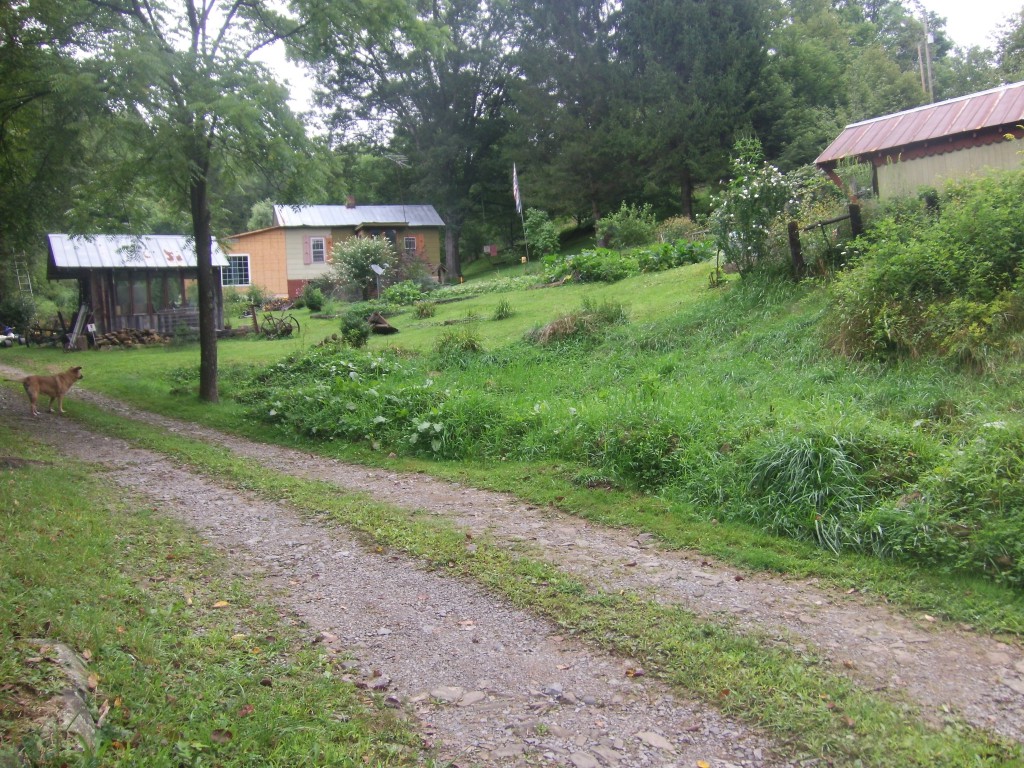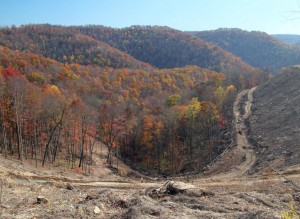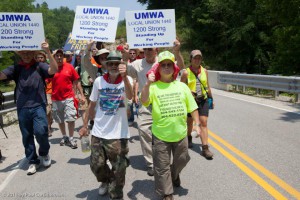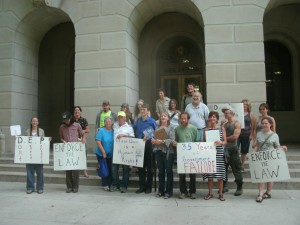ALL
Appalachia’s coal-bearing counties would directly benefit from the adoption of the POWER+ plan, a proposal in the Obama administration’s 2016 budget that would direct more than a billion dollars to Central Appalachia.
But last week, the U.S. Senate appropriations committee passed a budget bill the leaves out any mention of POWER+.
The U.S. House budget leaves Virginia entirely out of the forward-thinking Abandoned Mine Lands funding reforms that were spelled out in the POWER+ Plan. That component of the plan would send $30 million directly to the Virginia coalfields for economic development and put laid-off miners back to work cleaning up the messes left by coal companies.
Please contact your senators now to make sure they support a budget that includes a path forward for Appalachian communities.
For more background, we recommend this piece by Naveena Sadasivam for InsideClimate News, which details the curious quiet around POWER+ and how the plan has been pulled into the partisan bickering that’s embroiled the U.S. Environmental Protection Agency’s Clean Power Plan and the 2016 budget process as a whole.
Under the federal Abandoned Mine Lands program, sites that pose a threat to safety are prioritized over sites that offer a potential economic benefit if cleaned up. While this program has reduced potential hazards in the coal-mining regions of Appalachia and the U.S., it has done little to positively impact local economies.
The POWER+ Plan, however, calls for funds to be used for projects that not only improve the environment and reduce hazards, but also create an economic benefit for local economies.
There’s still time for both House and Senate to include the meaningful funding proposals outlined in POWER+. But in order for that to happen, we need to the Senate to hear a clear message that Appalachia deserves this much-needed funding!
Please contact your senators now to make sure they support a budget that includes a path forward for Appalachian communities.
No comments yet » Leave your own...
Announcing a new tool to end the destruction of Appalachian mountains and streams
Coal is in the news a lot these days. The market forces and much-needed environmental and health protections cornering the dirty fuel are topics of endless interest as America’s energy landscape shifts toward cleaner sources. And yes, all signs point to coal’s continued decline.
In many ways though, the forces chipping away at coal’s historic dominance are overshadowing another big story �” one that Appalachian citizens still need the public and policymakers to hear �” about just how much the human and environmental costs of mountaintop removal coal mining persist in Central Appalachia.
That mountaintop removal is an extremely dirty and dangerous way to mine coal has never been better understood. The overwhelming body of evidence is built on a foundation of the countless personal stories found in communities near mines and bolstered by dozens of studies investigating disproportionate health problems in coal-producing counties compared to elsewhere in Appalachia. More recently, advocates have employed technological tools to visualize complex data and add another dimension to arguments against the practice.
Appalachian Voices is committed to both creating a forum for those personal stories and sharing the most up-to-date data available about the ongoing risks mountaintop removal poses to our region’s communities and environment. Today, we’re excited to share a web tool we developed to reveal how mining continues to close in on nearby communities and send a resounding message to President Obama that ending mountaintop removal is a must if we hope to foster economic and environmental health in Appalachia.
Explore Appalachian Communities at Risk from Mountaintop Removal on iLoveMountains.org
The centerpiece of “Communities at Risk from Mountaintop Removal” is an interactive mapping tool on iLoveMountains.org that allows anyone to explore mountaintop removal’s expansion over the past 30 years.
Created using Google Earth Engine, U.S. Geological Survey data, publicly available satellite imagery, and mapping data and consultation from the nonprofit SkyTruth, the tool gives users greater perspective into the decades-long scourge surface mining has had on the Appalachian landscape and generations of families that live in the region.
The Communities at Risk tool also concentrates on impacts at the community level, where the powerful personal stories that first brought mountaintop removal to the forefront of the nation’s consciousness and agenda for environmental change are found.
Fifty communities spread across Kentucky, Virginia and West Virginia are identified by the tool as being the most at risk. By clicking on a community icon on the map, you can see the number of acres classified as active mining within a 1-mile radius of a particular place over time. In some communities, the number has fallen. In others, it has grown dramatically in recent years even as regional coal production has plummeted.
In the coming months, we’ll take a closer look at a handful of these communities, sharing local perspectives on how the proximity of mountaintop removal has affected local livelihoods. Our first “featured community” is Inman, Va., a small town in Wise County, where residents have successfully battled back a proposed massive mountaintop removal mine while experiencing the devastating impacts of another. You’ll also see stories about featured communities on AppalachianVoices.org and in upcoming issues of The Appalachian Voice newspaper.
Learn about Inman, Va., from local residents Matt Hepler and Ben Hooper
If you want a fuller picture of the data we used to create the mapping tool, check out the companion white paper, which describes the background, methods, results and implications of our initial research.
Over time, we’ll work with impacted citizens in communities near active and proposed mines to expand the use of the tool and update our maps with current, high-resolution satellite imagery we’ll obtain through a partnership with Google’s Skybox for Good project. We’ll use those images to improve interactions between citizens and regulators, share information with our allies and
Read our white paper for an in-depth look at the ways mountaintop removal continues to put Appalachian communities at risk.
The constant flow of news describing something close to the death of the Appalachian coal industry could leave outside observers with the impression that the problems of mountaintop removal have been resolved by the industry’s collapse. That impression, however, is at odds with the personal experience of many Appalachian citizens, the visible impacts of mining in communities across the region and the data that comprises Communities at Risk.
Visit communitiesatrisk.org to explore the mapping tool, learn more about the 50 most at-risk communities and tell President Obama that more must be done to protect Appalachian communities.
1 Comment » Leave your own...
From the press release:
On March 17th, seven local, regional and national groups filed a formal notice of intent to sue the U.S. Office of Surface Mining for failing to intervene on West Virginia’s lax oversight of mountaintop-removal and other destructive surface coal mining �” a state program that has, for decades, allowed the coal industry to ravage the environment, putting people at risk and destroying local communities.
The state’s chronically poor oversight has included a persistent failure to conduct inspections meant to protect people and the environment from coal companies that operate outside the law. Out-of-control mountaintop-removal coal mining is linked to epidemics of cancer, cardiovascular disease and birth defects in affected communities. West Virginia has also failed to undertake required assessments to ensure lakes, rivers and drinking-water wells aren’t harmed by mountaintop-removal mining and other destructive surface coal-mining practices.
Learn more about this important case at Coal River Mountain Watch’s website.
1 Comment » Leave your own...
On Monday, March 16, those fed up with the toxic legacy of coal in West Virginia are gathering at the Department of Environmental Protection’s headquarters in Charleston to declare: “No More Mountaintop Removal Permits!”

A year after the coal chemical disaster that endangered the health and local economy for more than 300,000 people, and in the face of 25 peer-reviewed scientific studies showing the devastating connections between people’s health and mountaintop removal, a diverse coalition known as “The People’s Foot” is putting their foot down at the West Virginia Department of Environmental Protection and demanding real change and real protections for West Virginia.
Come to the WVDEP headquarters at 601 57th Street Southeast, Charleston, WV 25304 from 11:00-1:00 on Monday, March 16 for “No More MTR Permits Day.” Let them know that we will not tolerate more threats to our people’s health. Get a free t-shirt if you’re one of the first 125 people to show up. Signs will be provided, so come on down and bring a friend!
To learn more about the event and RSVP, visit the facebook page!
Hope to see you in Charleston next Monday!
No comments yet » Leave your own...

The U.S. Senate has been in session for less than three weeks, and they have already begun an attack on the Appalachian mountains and surrounding communities.
Coal industry boosters have introduced a pro-mountaintop removal coal mining amendment and they are trying to attach it to the Keystone Pipeline bill, which is expected to be voted on this week.
The amendment, introduced by Sen. Dan Coats of Indiana, would block the Department of Interior from completing its ongoing rewrite of the Stream Protection Rule. The coal industry is afraid that a strong rule would make it harder for them to continue blowing up mountains and dumping the waste in streams.
Join us in fighting against this mountaintop removal amendment by writing to your senator.
We need the Department of Interior to introduce a strong Stream Protection Rule that would help us put an end to mountaintop removal once and for all. They have been writing the rule for several years, and are expected to release it this Spring.
Please contact your senator and ask them to oppose the Coats mountaintop removal amendment.
No comments yet » Leave your own...

Great news! In a huge victory for our water and our future, a federal appeals court stated the U.S. Environmental Protection Agency and the U.S. Army Corps of Engineers are authorized to enforce laws on water pollution from mountaintop removal mines.
After years of effective organizing, our movement pressured the EPA to issue a water quality guidance in 2011 that used peer-reviewed science to show the devastating impacts that mountaintop removal coal mining has on Appalachia�s water. Unfortunately, a coalition including the National Mining Association and the state governments of Kentucky and West Virginia sued to prevent the EPA from protecting our water from dangerous coal pollution.
This important ruling says that the EPA was correct to enforce the law and follow the science to protect Appalachian waters and community health.
Tell the EPA it’s time to get to work!�State politicians will continue to tie the hands of regulatory officials that would conduct meaningful water quality oversight. We need a federal rule that supersedes the corruption of state politicians and makes a real difference for Appalachian water and the future of our communities.
Last week�s important court ruling echoes what residents have said for years: we need strong standards from the EPA to protect the waters of Appalachia from the dangers of mountaintop removal and a coal industry run amok.
Send a letter to the EPA to tell them that water protection can�t wait!
No comments yet » Leave your own...
Guest blog by Laura Rigell with Keeper of the Mountain Foundation

The connection between healthy land and human life is easy to ignore in a concrete jungle such as Charleston. Even rural West Virginia has become speckled with Dollar Generals and One Stops, which can provide for all our basic needs. Nevertheless, many residents still grow backyard gardens and preserve produce to last until the next summer. Gardeners and farmers uphold the region�s legacy of living off the land.
Today, an obstacle to true self-sufficiency is the lack of local control over the way the land is used. Around the turn of the 20th century, logging and mining companies bought out much of this state�s natural resources. Tycoons often selectively purchased timber or mineral rights, undermining residents� sovereignty. Doing so involved severing those rights to extraction from the right to use the surface. This has left most residents of southern West Virginia without ownership of the minerals under their property. To access those subsurface resources, the mineral owner can damage the surface as much as is “reasonably necessary.” Without a long-term interest in this region, extractive industries often pillage the surface, leaving behind eroding mountains that are unsuitable for growing crops or harvesting water.
In recent decades, some institutions have come to recognize the importance of healthy land. Though public protection is a common approach to conservation, one tool that has become popular is the conservation easement. A conservation easement is a uniquely private form of land use control. Through an easement, a landowner restricts the way his/her property can be used. Often, landowners forbid development or logging, to permanently preserve a farm or forest. These restrictions accompany his/her deed forever, and are enforced by a non-profit entity called a land trust. The land trust visits the property annually to assure that the current residents are abiding by the easement. If there is an easement violation, for example someone has clear-cut a forest, the land trust addresses this by negotiating with the resident or, if necessary, filing a lawsuit.
Currently, land protection through conservation easements is not an option for most Appalachians. The region�s conservation organizations have been accessible to only a minority of the population- those privileged with mineral ownership, large tracts of land, and disposable incomes. Existing conservation efforts, though valuable, do not actively confront the assault on people�s welfare by land speculation, unsustainable development, and mineral extraction.
I spent last summer as an intern with Coal River Mountain Watch. I researched the relationship between easements and mineral rights and decided that easements could play a protective legal role even for severed parcels. This discovery led me to propose the establishment of a new land trust, that aims to work with small, less economically-advantaged residents to protect their land. Keeper of the Mountains Foundation (KoTM) agreed to take on this role.
Keepers began by overseeing the easement for Sid and Dana Moye, which mandates that their 24-acre parcel remain farmland forever, with some of the forest permanently protected. The Moyes not own the minerals under most of their property, though this easement will likely dissuade extractive companies from mining on the Moyes� land. Keepers will not limit the scope of its easements by requiring a minimum acreage or monetary contribution. Because of this, Keepers has the potential to make land protection accessible to all Appalachian residents.

By the end of 2014, Keepers aims to have 1000 acres of land protected in easements. Work towards this goal will begin this summer, with the support of CRMW interns. These interns, including myself, will be using the Moyes� 30-page easement as a template to draft easements for four more residences.
My vision for this new land trust initiative is to re-situate Appalachians as authors of their own futures. I see the potential for these easements to draw the age-old connection between people and land health. As in the case of the Moye property, easements can promote uses that prioritize community and ecological welfare. By promoting responsible land uses, these easements can lift up the Appalachian heritage of self-sufficiency and local resilience.
No comments yet » Leave your own...

From the Friends of Blair Mountain (Website | Facebook ):
WVDEP has issued an order to Aracoma Coal that will prohibit any surface mining within 1,000 ft. of the Blair Battlefield until 2018 when the permit comes up for renewal.
More importantly, OSMRE, a federal agency, has confirmed and established the legal steps to take so that Governor Tomblin can issue an executive order giving WVDEP the power to enforce section 106 of the National Historic Preservation Act on a 1,000 ft. boundary around the entire Blair Battlefield.
The 1921 Battle of Blair Mountain was fought along a number of fronts, the Battle for Blair Mountain has been no different. A pivotal front in the ongoing Battle for Blair Mountain is the Camp Branch Permit. Encompassing part of the southern area of the battlefield, the land on Camp Branch was where Sheriff Don Chafin kept his supply lines running and where defensive positions were stationed on the ridgeline at Blair. In the Battle for Blair Mountain, the Camp Branch Permit has been the most heated front. Just a few months after the 2011 protest march to save Blair Mountain there were rumors of activity around Camp Branch. A few months later, our board members withstood violent threats at the Camp Branch Permit hearing from hundreds of miners who had been told the approval of the permit would create coal jobs. On September 10, 2013, FOBM board members were physically threatened and intimidated with armed force when our organization attempted to conduct a citizen�s site inspection accompanied by the West Virginia Department of Environmental Protection.
Friends of Blair Mountain requested a site inspection because our organization found evidence that portions of the Blair Battlefield were being illegally destroyed on the Camp Branch Permit. Our first site inspection was forced to an early close and we were unable to document our findings. We appealed to the West Virginia Surface Mine Board and, on December 9, 2013 won a hearing which granted us the right to conduct a second site visit and film it. On March 11, 2014 we conducted this site visit and filmed areas where significant areas of the battlefield on the Camp Branch Permit were destroyed through logging and construction methods.

The late Larry Gibson (right) and others during the 2011 March on Blair Mountain
Upon taking our evidence to the appropriate regulatory agencies and conducting a number of meetings, FOBM finally gathered all the relevant regulatory agencies, the Office of Surface Mining Reclamation and Enforcement, the Army Corps of Engineers, and WVDEP together to discuss protecting the Camp Branch Permit and the Blair Battlefield on May 2, 2014.
We have stopped them at Camp Branch. Now Governor Tomblin must be convinced to issue an executive order to save the Blair Battlefield from all corporations. The legal apparatus is in place, all it takes is his action.
Furthermore, all of the regulatory agencies confirmed in our May 2, 2014 meeting that the destruction we have found and documented on the battlefield is not mining related nor can it be classified as pre-mining activity. In other words, parts of the battlefield have been destroyed and yet not one lump of coal has been extracted, not one coal mining job was created, and no mining is planned where the disturbances took place. This is all verified by inspections conducted by WVDEP and ACOE on April 16 and 29, 2014.
If Governor Tomblin will act, then what remains of the Blair Battlefield can be preserved. We can still preserve this ground, build a place where the public can celebrate and learn from this great history, and help diversify the local economy.
The Battle for Blair Mountain has many fronts. We have beat them back at Camp Branch. Now it is time to win the rest before they can launch another assault on our history.
Friends of Blair Mountain will be working for an URGENT CALL to ACTION to GOVERNOR TOMBLIN.
1 Comment » Leave your own...

In a rare television interview, environmental legend and writer Wendell Berry spoke with Bill Moyers about activism and his love of Appalachia.
The federal government is shut down and Congress is failing to act on important issues as they battle over the budget. But across Appalachia, citizens have not quit. We are continuing the work to end mountaintop removal.
In the last three weeks alone, groups in the region have held more than half a dozen gatherings to test water, petition state agencies for stronger enforcement and celebrate the communities we have come together to protect.
As groups continue to grow locally, the fight to end mountaintop removal is in the national spotlight. This weekend, impacted citizens will provide leadership at Powershift 2013 in Pittsburgh, Pa.
Also, renowned author and mountaintop removal activist, Wendell Berry, recently spoke with Bill Moyers about his activism and a no-compromise plan to protect our families and future. You can watch it here!
Thank you for fighting to end mountaintop removal.
No comments yet » Leave your own...

A group of West Virginia citizens gather in front of the Charleston, W.Va., location of the federal Office of Surface Mining, where they delivered a 100-page petition detailing a litany of problems with the state regulatory program before marching to the state Capitol to deliver a copy of the petition to Governor Earl Ray Tomblin.
Charleston, W. Va. � Today a coalition of 18 state and national organizations filed a formal administrative law petition with the Federal Office of Surface Mining Reclamation and Enforcement (OSMRE) alleging widespread problems with the state Department of Environmental Protection’s (DEP) enforcement of the Surface Mine Control and Reclamation Act (SMCRA) and demanding federal intervention. The nearly 100 page petition filed today details a litany of problems with the state regulatory program including granting and renewing mining permits illegally, systemic failures to properly assess the risks of flooding from mine sites, drastic understaffing, and failure to assess meaningful penalties for violations of the law. A group of West Virginia citizens gathered a press conference today in front of the Charleston Office of Surface Mining to deliver the petition and then marched to the state Capitol to deliver a copy to Governor Tomblin.
“The situation here couldn’t be more urgent. Every year there is another flood, another stream dies, another health study comes out showing the devastating effects of unenforced mining law on our communities. We need action and we need it now,” said Debbie Jarrell, Coal River Valley resident and Co-Director of Coal River Mountain Watch.
The filing of the petition represents the first step of the Citizen Action for Real Enforcement (CARE) Campaign, a new effort bringing together citizens and groups across the state to demand accountability from the state’s government and address what they say are decades of failures by state agencies. Currently, the state DEP has the authority and responsibility to enforce federal laws on mining. The petition was filed under a provision of SMCRA that allows citizens to ask the federal OSMRE totake over a state agency if they believe the agency is failing to enforce the law. The filing of this petition triggers an obligation on the part of OSMRE to investigate the citizens’ claims and, if they are deemed valid, to order changes in the state program or assume enforcement themselves.
“People who have lived in the coalfields for generations have reached out to our DEP for help. After many years of pleading our case, we have no confidence in our DEP, nor should we. Our only option is to seek federal intervention to assure that our communities get what everyone deserves – protection from the pollution and toxins that are directly impacting the health of the people that live within these communities,” said retired UWMA miner Chuck Nelson.
(more…)
1 Comment » Leave your own...



















